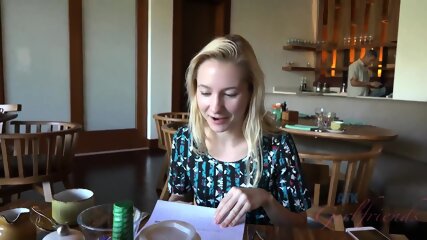Zobacz Jej Cipkę 546min720p60fps
Zaproponuj Kategorię
Głosuj na obecne kategorie
Dodaj nową kategorię
Zasugeruj opis
Głosuj na istniejące opisy
Zaproponuj nowy opis dla tego filmu
Description must have at least 50 characters. Current characters: 0
Advertisement
Oceanography (from Ancient Greek ὠκεανός (ōkeanós) 'ocean', and γραφή (graphḗ) 'writing'), also known as oceanology and ocean science, is the scientific study of the oceans. It is an Earth science, which covers a wide range of topics, including ecosystem dynamics; ocean currents, waves, and geophysical fluid dynamics; plate tectonics and the geology of the sea floor; and fluxes of various chemical substances and physical properties within the ocean and across its boundaries. These diverse topics reflect multiple disciplines that oceanographers utilize to glean further knowledge of the world ocean, including astronomy, biology, chemistry, climatology, geography, geology, hydrology, meteorology and physics. Paleoceanography studies the history of the oceans in the geologic past. An oceanographer is a person who studies many matters concerned with oceans, including marine geology, physics, chemistry and biology.
Contents
1 History
1.1 Early history
1.2 Modern oceanography
2 Branches
2.1 Biological oceanography
2.2 Chemical oceanography
2.2.1 Ocean acidification
2.3 Geological oceanography
2.4 Physical oceanography
2.4.1 Seismic Oceanography
2.4.2 Ocean currents
2.4.3 Ocean heat content
2.5 Paleoceanography
3 Oceanographic institutions
4 Related disciplines
5 See also
6 References
6.1 Sources and further reading
7 External links
History
Map of the Gulf Stream by Benjamin Franklin, 1769–1770. Courtesy of the NOAA Photo Library.
Early history
Humans first acquired knowledge of the waves and currents of the seas and oceans in pre-historic times. Observations on tides were recorded by Aristotle and Strabo in 384-322 BC.[1] Early exploration of the oceans was primarily for cartography and mainly limited to its surfaces and of the animals that fishermen brought up in nets, though depth soundings by lead line were taken.
The Portuguese campaign of Atlantic navigation is the earliest example of a systematic scientific large project, sustained over many decades, studying the currents and winds of the Atlantic.
The work of Pedro Nunes (1502-1578) is remembered in the navigation context for the determination of the loxodromic curve: the shortest course between two points on the surface of a sphere represented onto a two-dimensional map.[2][3] When he published his "Treatise of the Sphere" (1537), mostly a commentated translation of earlier work by others, he included a treatise on geometrical and astronomic methods of navigation. There he states clearly that Portuguese navigations were not an adventurous endeavour:
"nam se fezeram indo a acertar: mas partiam os nossos mareantes muy ensinados e prouidos de estromentos e regras de astrologia e geometria que sam as cousas que os cosmographos ham dadar apercebidas (...) e leuaua cartas muy particularmente rumadas e na ja as de que os antigos vsauam" (were not done by chance: but our seafarers departed well taught and provided with instruments and rules of astrology (astronomy) and geometry which were matters the cosmographers would provide (...) and they took charts with exact routes and no longer those used by the ancient).[4]
His credibility rests on being personally involved in the instruction of pilots and senior seafarers from 1527 onwards by Royal appointment, along with his recognized competence as mathematician and astronomer.[2] The main problem in navigating back from the south of the Canary Islands (or south of Boujdour) by sail alone, is due to the change in the regime of winds and currents: the North Atlantic gyre and the Equatorial counter current [5] will push south along the northwest bulge of Africa, while the uncertain winds where the Northeast trades meet the Southeast trades (the doldrums) [6] leave a sailing ship to the mercy of the currents. Together, prevalent current and wind make northwards progress very difficult or impossible. It was to overcome this problem and clear the passage to India around Africa as a viable maritime trade route, that a systematic plan of exploration was devised by the Portuguese. The return route from regions south of the Canaries became the 'volta do largo' or 'volta do mar'. The 'rediscovery' of the Azores islands in 1427 is merely a reflection of the heightened strategic importance of the islands, now sitting on the return route from the western coast of Africa (sequentially called 'volta de Guiné' and 'volta da Mina'); and the references to the Sargasso Sea (also called at the time 'Mar da Baga'), to the west of the Azores, in 1436, reveals the western extent of the return route.[7] This is necessary, under sail, to make use of the southeasterly and northeasterly winds away from the western coast of Africa, up to the northern latitudes where the westerly winds will bring the seafarers towards the western coasts by
tozmisalad
Komentarze
Napisz, co Ci się podoba w tym filmie porno, aby podzielić się tym z innymi. Zapytaj o gwiazdę porno, która występuje na tym nagraniu lub podziel się swoją wiedzą z innymi.
Czy wiesz, że ?
In the America, the making of porno videos or acting in porno is only legal in Los Angeles and New Hampshire.
Najlepsze komentarze tygodnia
Hello
Przez: Tomtom29 | W: When My Husband Goes Outside For 5 Minutes To Smoke, My Father-In-Law Immediately Pounces And Fucks Me Until He Cums Inside Me... - Akari NeoWhat can be better than a cute girl with small titties?
Przez: DianaX731 | W: Busty MILF Lory Lace Shows Her Son's Friend How To Fuck A Woman













![[jav] Synowa Córka Natsuki Traci Dziewictwo Analne.](https://static-ca-cdn.eporner.com/thumbs/static4/1/10/100/10035179/8_240.jpg)






















